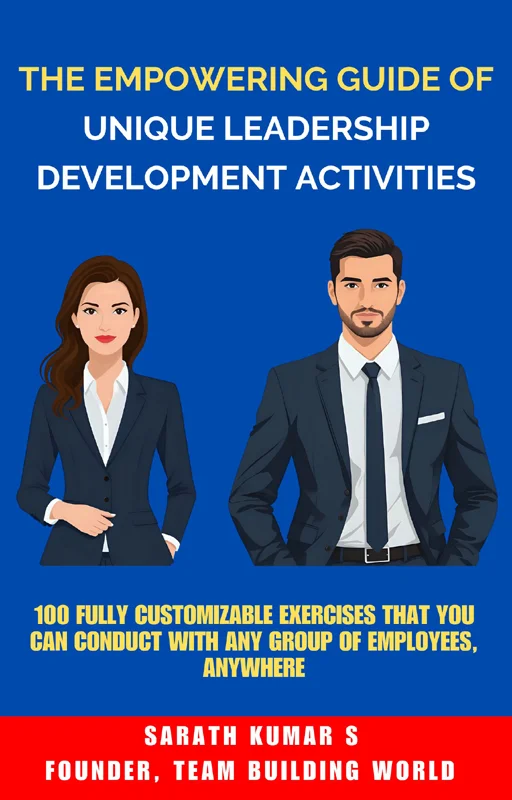10 Risk Taking Team Building Activities (With Debrief)
Are you in search of some risk taking team building activities for your employees?
When it comes to business, taking risks can often lead to great rewards. Successful leaders know how to take calculated risks in order to drive growth and innovation.
In this article, we will explore 10 risk taking activities that you can try with your teams. These exercises can push your employees out of their comfort zones while fostering teamwork.
10 Risk Taking Team Building Activities
Here are some team building exercises that will help improve your employees’ risk taking skills.
If you want some activities on creative thinking, you can read this article: 10 Creativity Team Building Activities (With Debrief)
So, let’s go!
#1. Zombie Apocalypse
This activity sharpens creative problem-solving and fosters a spirit of cooperation as teams face the pressure of a ticking clock. Much like in a high-stakes business environment, employees must collectively brainstorm and implement strategies to ‘survive’ a series of challenges.
Time: You decide
Materials: Task cards with puzzles, and a timer
Participants: Groups of 3-6 individuals
Instructions
- Divide the participants into teams.
- Distribute the first task card to each team. For instance, the task could involve solving a riddle or cracking a code.
- Set the timer and allow the teams to start solving the puzzle. For each task, there should be a certain time limit. Failure to complete the task within the given time results in ‘losing’ a team member. In this case, the team has to complete the next task with one less person.
- The team that successfully completes all the tasks in the least amount of time will ‘survive’ the zombie apocalypse.
What is the Risk Here: Time pressure and limited resources can result in heightened stress levels and potential conflict.
Debrief
Reflect on the experience by discussing the effective strategies, the obstacles that arose, and the importance of agile thinking. Compare the game’s time-sensitive problem-solving with the dynamic decision-making required in business.
You can also read: 10 Product Management Games for the Workplace
#2. Shark Tank Pitch
Teams will gain experience in both innovation and presentation skills in this activity modeled after the popular TV show. They develop a novel product or service and work together to create a convincing pitch.
Time: You decide
Materials: Whiteboard, and markers
Participants: 3-6 people per group
Instructions
- Give each group time to brainstorm and develop a unique product or service idea.
- Have them outline the key selling points, target market, and financial aspects of their idea.
- Each group pitches their concept to a panel of judges (the sharks) within a set time limit.
What is the Risk Here: Presenting in front of critical judges and peers adds to the pressure. Teams must be willing to face tough questions and potential criticism while defending their ideas.
Debrief
Discuss the creativity, persuasiveness, and teamwork displayed during the pitches. Encourage reflection on how these skills apply to client presentations and negotiations in a work setting.
You can also read: 10 Courageous Leadership Activities for the Workplace
#3. Wilderness Survival
This activity requires critical thinking, problem-solving, and effective communication skills to successfully survive in the wilderness. It is one of the risk taking team building activities that teaches the importance of adaptability in challenging situations.
Time: 15-20 minutes
Materials: A scenario card with a list of items
Participants: 3-6 people per group
Instructions
- Divide participants into teams and give them their assigned scenario.
- Provide each team with a list of items they have available to them and a time limit.
- Teams must work together to prioritize and use the items effectively to survive in their given scenario.
- After the time is up, they can present their survival plan and explain their thought process behind it.
What is the Risk Here: Depending on the scenario, teams may face various challenges such as extreme weather conditions or limited supplies.
Debrief
Encourage teams to share their strategies and experiences from the survival simulation. Highlight the importance of each member’s contribution to the group’s success.
You can also read: 10 Survival Leadership Activities for the Workplace
#4. Improv Workshop
Quick thinking and adaptability are essential in dynamic work environments. An improv workshop fine-tunes these skills in a fun, supportive setting.
Time: You decide
Materials: None
Participants: 4-8 people per group
Instructions
- Divide the participants into groups.
- Provide a scenario or theme for each group to improvise around. For example, a team meeting gone wrong or a sales pitch for an unusual product.
- Allow time for each group to prepare and then perform their improvisation in front of the others.
What is the Risk Here: Participants may feel uncomfortable or embarrassed at first, but remind them that it’s all part of the learning process and mistakes are welcome.
Debrief
Bring groups together to reflect on their improv experiences, emphasizing the skills gained in adaptability and rapid response. Discuss how these abilities transfer to real-world business interactions and client engagements.
#5. Treasure Hunt
Treasure hunts not only build teamwork but also sharpen problem-solving skills. Here teams interpret clues, strategize the best routes, and race against the clock in a thrilling search for the prize.
Time: 10-20 minutes
Materials: Clues, and a gift item that represents ‘treasure’
Participants: 3-6 people per team
Instructions
- Split the participants into teams.
- Provide each team with the first clue that will lead them to another location where they can find the next clue.
- This process continues until they reach the final destination where they can have the ‘treasure’.
- The first team to find the treasure wins.
What is the Risk Here: Teams may experience conflict when strategies differ, but this also provides valuable lessons in negotiation and compromise.
Debrief
Discuss the strategies that led to success and the challenges faced during the hunt. Relate the treasure hunt to navigating business challenges and achieving goals through effective teamwork.
#6. Resourcefulness Game
Drawing from the intense competition of the renowned TV series, Resourcefulness Game pits teams against each other in a series of strategic challenges. It is a test of teamwork as groups vie to accumulate resources and outperform their rivals.
Time: You decide
Materials: Resource tokens (For example, sticks, paperclips, toothpicks, etc.)
Participants: Groups of 3-8 individuals
Instructions
- Divide the participants into teams. Distribute the resource tokens evenly among the teams.
- Assign each team a challenge to complete. For example, building a structure with the given resources. Explain to them that they should use their resources effectively to complete challenges and earn points.
- Teams will race against the clock to complete each challenge, earning more resource tokens for their performance. The tokens can be traded with other teams for advantages, such as extra time or hints for future challenges.
- The team with the most points at the end wins.
What is the Risk Here: Teams may face the risk of resource depletion and the need for tactical decision-making under competitive pressure.
Debrief
Discuss the importance of resource management and strategic thinking in a competitive environment. Analyze the decisions made by successful teams and how they could be applied to real-world business scenarios.
#7. Blind Drawing
This exercise can improve communication and trust among team members. One person interprets a hidden image and guides their teammates through words alone, turning communication into a tangible picture.
Time: 15-20 minutes
Materials: Paper, pens, and a selection of images
Participants: Pairs
Instructions
- Pair up the participants and have one member view a picture without revealing it.
- The viewer describes the image while their partner draws what they interpret.
- Finally, compare the drawing with the actual image.
What is the Risk Here: Miscommunication and trust issues can arise if instructions are not clearly given.
Debrief
Reflect on the importance of clear communication and active listening in achieving a common goal. Discuss ways to improve communication within the team.
#8. Simulated Stock Market Challenge
In this high-stakes simulation, teams step into the financial arena to manage a mock stock portfolio. It’s a race against the market where strategy and risk go hand-in-hand.
Time: You decide
Materials: Mock stock market portfolio, and virtual trading platform
Participants: Groups of 3-6 individuals
Instructions
- Prior to the activity, each team will be given a mock stock portfolio consisting of various stocks from different industries.
- Using the virtual trading platform, teams will have to buy and sell stocks to achieve maximum profit.
- Teams must research market trends and company performance in order to make informed decisions.
- At the end of the allotted time, the team with the highest profit wins.
What is the Risk Here: Teams may face losses or gain unexpected profits due to market fluctuations, making it a high-pressure and unpredictable challenge.
Debrief
Discuss the importance of strategic decision-making, risk assessment, and adaptability in a volatile market. Encourage participants to reflect on their own risk tolerance levels and how it affects their decision-making process.
#9. Escape Room Challenge
This is an immersive problem-solving activity requiring employees to unlock a room and escape before the time runs out.
Time: 15-20 minutes
Materials: A set of puzzles
Participants: 4-8 people per group
Instructions
- Divide the employees into groups and assign each group a different themed room, such as a bank heist or archaeological dig.
- Give them a set of puzzles and clues that must be solved in order to escape the room.
- Set a time limit for each group to solve the puzzles and escape the room.
What is the Risk Here: Time pressure and limited resources can increase the risk of failure, requiring teams to think quickly and take calculated risks.
Debrief
Discuss with the teams what strategies worked, what risks they took, and how they felt during the activity. This reflection helps them draw parallels to workplace scenarios where they might face similar pressures and the necessity of taking risks to achieve their objectives.
#10. Balloon Risk Rally
This playful yet insightful exercise enhances team dynamics by encouraging risk-taking under uncertainty.
Time: 10-15 minutes
Materials: Balloons (2 per participant), pins, and blindfolds
Participants: Groups of 3-6 individuals
Instructions
- Each group is given a set of balloons and must choose two to inflate. One represents a ‘low-risk investment’ and is inflated just enough to stay afloat, the other a ‘high-risk investment’ is inflated to near capacity.
- Group members take turns wearing a blindfold and with a pin in hand, must decide which balloon to ‘invest’ in by popping it.
- The catch: group members can only use vague hints from non-blindfolded members to gauge the risk.
What is the Risk Here: The blindfolded participant must rely on their intuition and their teammates’ limited guidance to make a decision.
Debrief
Facilitate a discussion on the group’s strategies for selecting balloons and how they relate to risk-taking in the workplace. Encourage participants to reflect on the importance of communication and collaboration in navigating uncertainty.
Want Some Unique Team Building Activities?
If you want some unique team building exercises for your employees, you can get my new e-book:
Or Want Some Unique Leadership Development Activities?
If you want some unique activities to equip your employees with leadership skills, qualities, and mindset, you can get my new e-book:
Final Words
Incorporating elements of risk and uncertainty in team exercises can provide valuable insights into decision-making processes under pressure. As a leader, it is important to encourage open communication, critical thinking, and collaboration among your employees. This will help you effectively navigate financial stress and make strategic decisions.

